Monika Filipiak Peszek
About two years after my daughter was born, I was depressed. I didn’t want to go anywhere or do anything. I could feel myself growing heavier and heavier, and angrier and angrier. I was mad at my husband all the time. I blamed him for the way I was feeling. I was afraid for my daughter as more and more people told me how beautiful she was and what a heartbreaker she would be. I started to think that people in my life would be happier without me.
I knew I had to get help.
At the first session with my therapist, I told him I was there to talk about my husband. Instead, out of nowhere, I started talking about the sexual abuse.
As the sessions continued, I realized it wasn’t my husband I was angry with.
When I began therapy, I wasn’t painting. My dreams of being an artist were gone. As an immigrant and a new mom I was doing whatever I had to do to survive in my new country. My therapist asked me, “What did you want to be when you were little?” I couldn’t answer him. He had some wonderful prints of Chagall paintings on his office walls, and all I could do was point to them. “Next time,” he said, “why don’t you bring me a painting of what you feel?”
That first painting wasn’t very good. I think it was of a dark room, with a door opening up into a beautiful, sunlit garden. My therapist asked me to dig deeper. I began painting more, and usually brought one or two to each session.
Later, as suggested by my therapist, I took several of these paintings to an informal meeting with an admissions counselor at the School of the Art Institute in Chicago. I was told that if I could bring in 15 paintings “just like that,” I might have a chance at a merit scholarship. The deadline was three weeks away. I put together a portfolio of my work, submitted it in time for consideration, and was accepted. Putting together this body of work—dealing with my demons, fighting the fear and shame—helped me put my life back on the right track. It was a scary journey, but I learned a valuable lesson: “Always do what you are afraid to do.”
I now see the entire process as a big circle, where everything came together in the end and made sense. I hope you can see it too.
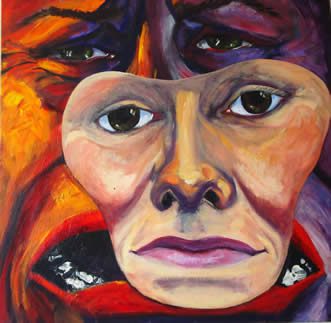 |
“Normal”
Acrylic on canvas, 36 x 36 After telling my story to someone who knew me for a while—or at least she thought she did—she said, “You don’t look like someone who’s been abused.” I wanted to laugh. What does a victim of a sexual abuse look like? Look around you … It is estimated that there are over 60 million survivors of childhood sexual abuse in America today. We learn to hide the pain. We wear a mask of “normal” because you can’t function in our society without one. Nobody wants to look at pain. I don’t like to look at it either.
|
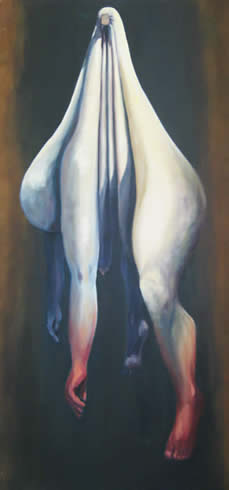 |
“Hang In There” Acrylic on canvas, 24 x 48 There were periods in my life when I was in a really dark and painful place. I did not want to see or talk to anybody. People can say the most inappropriate things, often with the best possible intentions: Why can’t you just get over it? It happened so long ago … let it go. Stop living in the past and think about your future! |
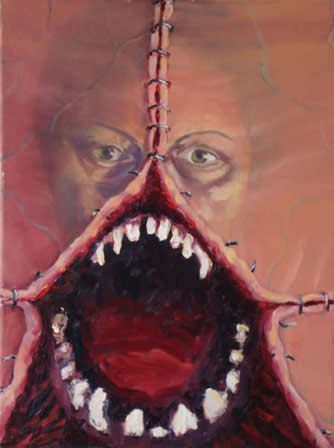 |
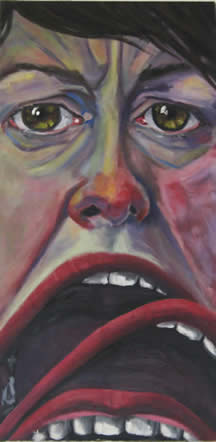 |
| “The Monster”
Acrylic on canvas, 18 x 24 The anger, the screaming, the monster inside me. Where was all this rage coming from? For years, I didn’t want to understand. Denial is protection. I simply wasn’t ready to face who I was really furious with … |
“NO!”
Acrylic on canvas, 18 x 36 I want to scream the word “NO!” and I do. I scream it over and over, but nobody wants to hear it. And so it keeps happening, over and over again. |
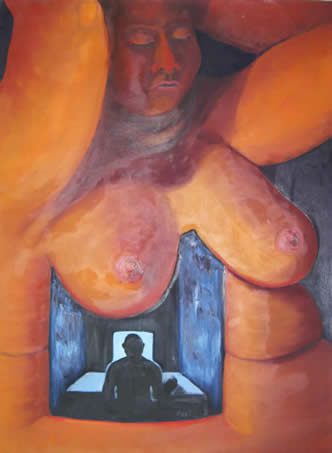 |
 |
| “The Invader”
Acrylic on canvas, 30 x 40 The abuser invades your territory and becomes a part of you forever. You are never just yourself—you become a land under occupation, ruled and programmed with fear and filled with feelings of worthlessness. He’s always present in the background, influencing every decision you make. The abuser kills the person you could have been. |
“Us”
Acrylic on canvas, 22 x 28 The little girl inside of me thinks that because I’m an adult I will protect her. But just in case, she wants thicker walls and more locks for her safe little world. So when she gets scared, I have to get bigger and heavier. Because she’s scared, I become colder, sarcastic, proud, and aggressive so that people stay away. |
| “Looking Out”
Acrylic on canvas, 24 x 20 I know how it feels to be scared of everything. Looking from the inside out at life, wanting to be happy and joyful, but not knowing how. The pain is just too big, too heavy to walk around with, and besides … every one will see it. |
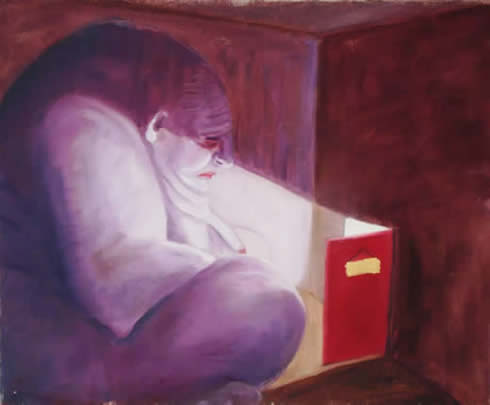 |
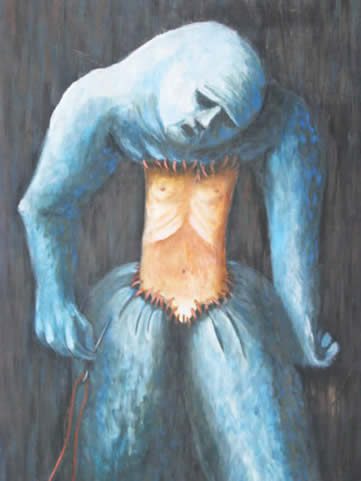 |
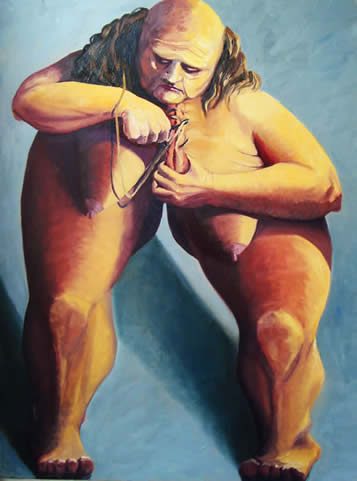 |
| “There Is No Center”
Acrylic on masonite board, 35 x 40 When I lay in bed and closed my eyes, I could feel my arms, my legs, my hands, and my head. But I couldn’t feel my torso. There was nothing at the center, at the core of me to hold me together. |
“Ripped Apart”
Acrylic on canvas, 30 x 40 For the longest time, I felt ripped apart, hollow, empty, and skinless. With these feelings came a need to feel whole and put together. I knew the only way to do it was to go back and revisit the abuse and the feelings it brought up in me. I expected it to be painful, like literally sewing myself back together. And it was. But without it, I wouldn’t be where I am now. |
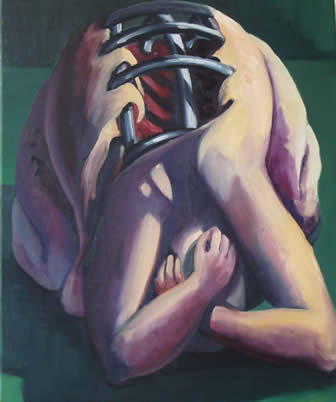 |
“Steel Inside” Acrylic on canvas, 20 x 24 You don’t have to live with an open wound forever. There is strength within you might not be aware of. You need help—but you have steel inside you, holding you together. You can’t see it, but it’s there. |
MONIKA FILIPIAK PESZEK‘s art is currently on display at the Awakenings Foundation Center and Gallery in Chicago, Illinois. If you need additional information about her work and are interested in purchasing or exhibiting it, please contact Jean Cozier, Awakenings Foundation President.
The Awakenings Foundation Center and its founder, Jean Cozier, are also featured in this issue. Read more in “Healing hidden Wounds”
Highlighted in Frontispiece Fall 2010- Volume 2, Issue 3
Fall 2010 | Sections | Gallery

Leave a Reply